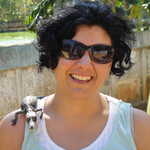

The Great Plains Buffalo
November 10th, 2013, 11pm
It was -15°C with scattered clouds. There was moderate breeze.
We can see the Buffalo of the Great Plains stretching for miles in this picture. We are so busy in our everyday lives that we sometimes fail to stop and enjoy the simpler things of nature. The Great Plains where these large buffalo herds once roamed was over 1.6 million square kilometers in size. The First Nations in this area were made up of the Cree, Saulteaux, Lakota, Dakota, Nakota, Dene and Blackfoot.
The buffalo were the main food source for the Plains First Nations. Hunting these great animals required a great amount of skill and bravery. Death could occur if a stampeding buffalo turned suddenly trampling a horse riding hunter and before horses, hunting this animal was even more difficult. Buffalo hunts required community participation from the hunt itself to the preparation of its useful materials. Every part of an animal had a purpose and each was made use of. They made tools, utensils, clothing, shelter, and water storage containers to name a few. The most important part of the buffalo was the lean mean which was high in protein. Meat would be eaten freshly roasted, in soup, or dried which allowed for longer storage. Pemmican was another food source made of dried buffalo meat, grease, berries and herbs. It was a compact, high protein food that was easy to transport.
The culture of the Plains First Nations revolved around the buffalo. The migrations of the great herds dictated the activities and movement of the plains people. The buffalo was a common theme included in many stories, games, and leisure activities. The Plains First Nations held ceremonies to offer thanks for the abundance of buffalo as they were regarded as the ‘Gift of the Great Spirit’. The buffalo was often associated with strength, endurance, and protection.
http://www.wanuskewin.com/seeking-knowledge/traditional-knowledge/ http://gprc.org/research/buffalo-commons/#.UoBZxfmsim4 photo: http://1onewolf.com/lakota/society18.htm
Filed Under
Other moments in The Pas
-
prairie first nations, indigenous, Brandon Story Class
The Seven Teachings are part of the First Nations Peoples lives, living on the Prairies here in Canada
in The Pas, Canada -
prairie first nations, indigenous, Brandon Story Class
Suicide on reserves
in The Pas, Canada -
Brandon Story Class, indigenous, prairie first nations
Alcoholism on reserves
in The Pas, Canada -
prairie first nations, Brandon Story Class
Pike Lake Culture Daylocal artist: Solomon Colomb 2002
in The Pas, Canada -
prairie first nations, Brandon Story Class
A look back to The Oka Crisis, 13 years ago.Part of my Winter Count
in The Pas, Canada -
Brandon Story Class
Pearl exclaims;"Can I help you with your homework"
in The Pas, Canada -
prairie first nations, Brandon Story Class
The ulu knife, traditionally the handle is made from caribou antler or walrus ivory. The blade was made of slate, until metal was introduced during the Fur Trade.
in The Pas, Canada -
prairie first nations, Brandon Story Class
Art from Baffin Island.
in The Pas, Canada -
prairie first nations, indigenous, Brandon Story Class
White Feather
in The Pas, Canada









